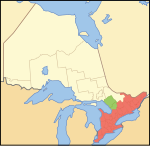CIDC-FM

CIDC-FM (103.5 FM, Z103.5) is a radio station licensed to Orangeville, Ontario, Canada. Owned by Evanov Communications, the station broadcasts a rhythmic contemporary format targeting the Greater Toronto Area. Its studios are located on Dundas Street West in the Eatonville neighbourhood in the Etobicoke district of Toronto. CIDC has historically been known for having a dance and electronic music-leaning format, and has sponsored electronic music events and co-branded dance music compilations. CIDC held a 2.0 share of the market in Numeris's Spring 2018 ratings.Due to its signal location near Orangeville, the station covers Barrie and Kitchener in addition to rimshotting Downtown Toronto. The station has often marketed itself as a Toronto station, while Evanov made repeated attempts to move or otherwise modify CIDC's signal to better serve the GTA, almost all of which were denied by the CRTC for neglecting its formal city of licence. The CRTC also reprimanded CIDC for not specifically devoting enough on-air community interest programming, news, sports and information specific to Orangeville or Dufferin County, as specified in its original approval.
Excerpt from the Wikipedia article CIDC-FM (License: CC BY-SA 3.0, Authors, Images).CIDC-FM
Charleston Sideroad, Caledon
Geographical coordinates (GPS) Address Nearby Places Show on map
Geographical coordinates (GPS)
| Latitude | Longitude |
|---|---|
| N 43.911944444444 ° | E -79.9375 ° |
Address
Charleston Sideroad 5702
L7C 2V5 Caledon
Ontario, Canada
Open on Google Maps







